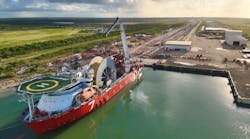Gene Kliewer • Houston
Subsea well intervention records set
ATP Oil & Gas Corp. and Blue Ocean Technologies set multiple new industry records in subsea well intervention while working over two gas production wells in 2,950 ft (900 m) of water and approximately 9,000 ft (2,743 m) downhole without a riser.
Blue Ocean’s Interchangeable Riserless Intervention System (IRIS) completed several riserless wireline runs to deploy intervention tools including a wireline tractor, gauges, milling tools, perforating guns, and a logging tool. Each run set a record for riserless intervention. This is the first successful wireline run in open water at that depth.
The final intervention operation was to deploy perforating guns to enable the commingling of the B & C Sands in Mississippi Canyon block 711 well No. 4ST1. After commingling the reservoirs located between 11,400 ft MD and 11,900 ft MD, production increased to 9 MMcf/d of gas and 4,900 b/d of oil with a flowing tubing pressure exceeding 3,100 psi (21.37 MPa). The MC 711 well No. 4ST1 is part of the Gomez Hub in the Gulf of Mexico.
This dynamically positionedHOS Iron Horse was the platform for IRIS.
More subsea work goes onto schedule in Brazi
It has been difficult lately to look at events in the subsea E&P business without a long look at Brazil, and this month is no exception.
First,Chevron Corp. says its Brazilian subsidiary will go forward to develop the Papa Terra project as its second deepwater development offshore Brazil.
Situated 70 mi (110 km) offshore in water depths of approximately 3,900 ft (1,190 m), Papa Terra is a heavy oil subsea development in block BC-20 of the southern Campos basin. Project plans call for the first tension leg wellhead platform offshore Brazil, which will be connected to an FPSO. The completed facility will be capable of producing up to 140,000 b/d of crude, according to Chevron.
First production from the Papa Terra project is expected in 2013.
Chevron holds a 37.5% interest in the Petrobras-operated Papa Terra, which is estimated to cost $5.2 billion to recover 380 MMbbl of oil.
In addition to the Papa Terra and Frade projects in the Campos basin, Chevron also holds a 30% non-operated interest in Maromba field where work continues to select a development scheme. In Brazil’s Santos basin, Chevron holds a 20% non-operated interest in block BS-4 where it continues to evaluate plans to commercialize Atlanta and Oliva fields.
In a continuing story,FMC Technologies has signed a subsea services contract with Petrobras which is expected to add $81 million to its work off Brazil. The scope of work calls for additional storage, maintenance, commissioning, and offshore services for subsea and topside control systems and drilling risers.
Aker Solutions also is looking at more work off Brazil. Aker says it is the low bidder on a four-year frame agreement to supply 61 subsea trees to Petrobras. Aker says it expects the final contract to be signed in the second quarter of this year following commercial negotiations and technical clarifications with Petrobras. Aker says it bid €195 million ($267.75 million).
Cameron reports first deepwater scale squeeze using MARS
In another worldwide first, Cameron reports completing its first deepwater scale squeeze using MARS for Chevron in Lobito Tomboco field, Angola. MARS is Cameron’s Multiple Application Re-injection System. Lobito Tomboco is in 600 m (1,968 ft) water depth. Chevron says it plans to use this system on 13 specially modified wells within the same area to maximize life of field production. The total scope of supply from MARS-PS includes the deployment and chemical handling interfaces in addition to the MARS hardware.
Chevron says it has plans to extend the MARS depth capability to 1,500 m (4,921 ft).
First VetcoGray SVXT S subsea trees go to Shell
GE Oil & Gas continues to make noise in the upstream E&P business. Shell UK Ltd. placed the first-ever order for VetcoGray’s SVXT S-series of subsea trees. GE says delivery is scheduled for 4Q 2010 with installation early in 2011.
The SVXT merges horizontal and vertical tree technology and is intended for harsh, shallow water fields such as many of those found in the North Sea, says GE. The SVXT design reduces tree weight by over 20%, decreases height, and delivers essential functionality in a pre-engineered, pre-configured “modular” systems approach, according to GE. Less expensive installation is possible because of a design that can be handled by standard jackups without major modifications.
Additional SVXT design features, says GE, include a fisher-friendly wellhead protection structures and a barrier that eliminates the need for a separate tree cap.






